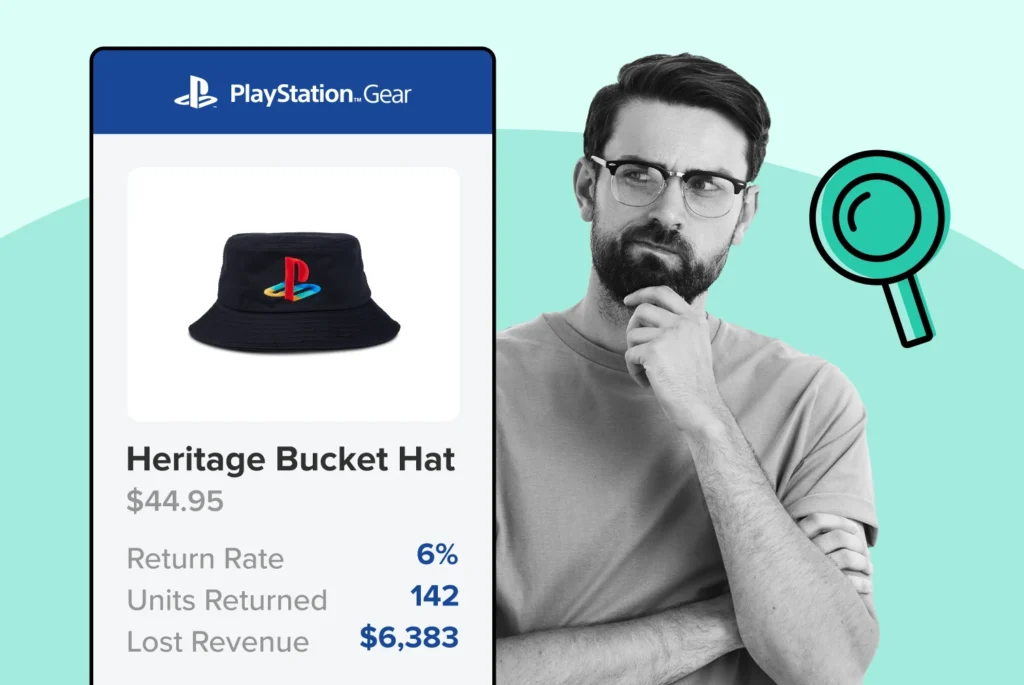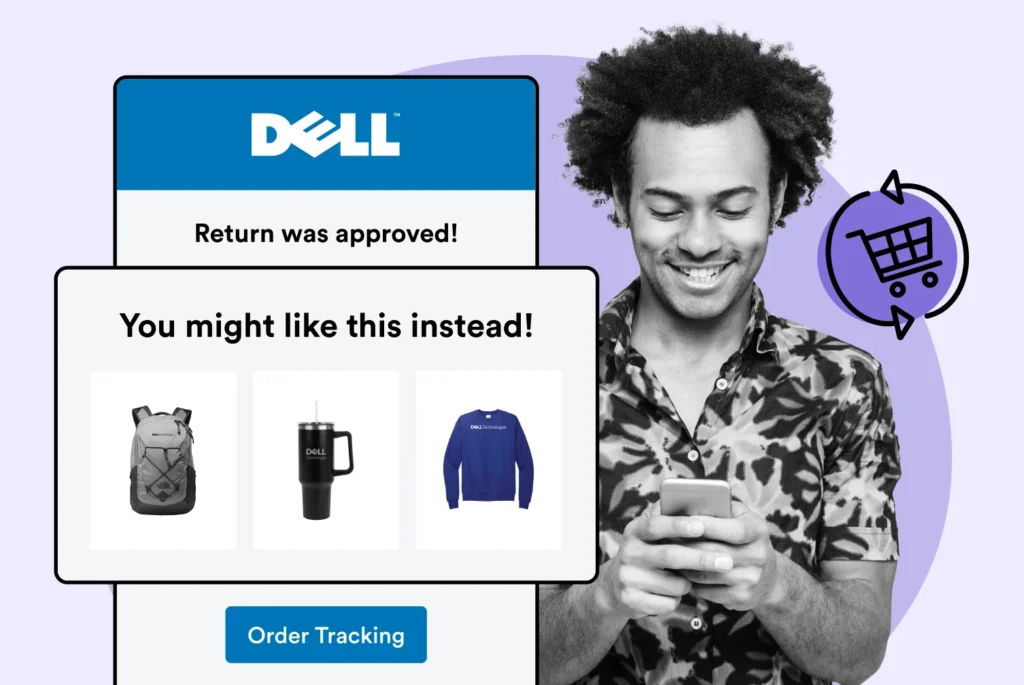
Track Your Returns with the Return Analytics Dashboard
Minimize returns and cultivate customer loyalty! Let’s explore how a return analytics dashboard can be critical to your business’s success!
Shipping, Tracking & Notifications
Boost customer experience and reduce support tickets
Realtime order and shipment tracking
Proactive order and shipping notifications
AI-Enhanced Discounted Labels
Predictive pre-purchase estimated delivery dates
Self-Serivce branded order tracking
Effortless experience delivered
Identify and Resolve Order Issues
Realtime order and shipment tracking
Make returns profitable and delight customers
Flexibility to define any return destinations & conditions
Simplify returns for your customers and team
Incentivize exchanges over returns
Returns management made easy for your team
Returns management made easy for your team
Easy claims and smart upsells
Understand why your customers are returning
In-Store & Curbside Pickup
Unify the online and the in-store experience
Hassle-free pickup experience for customers
In-Store dashboard to keep operations streamlined
In-Store and Online orders unified
Drive foot-traffic to your stores
Shipping, Tracking & Notifications
Boost customer experience and reduce support tickets
Realtime order and shipment tracking
Proactive order and shipping notifications
AI-Enhanced Discounted Labels
Predictive pre-purchase estimated delivery dates
Self-Serivce branded order tracking
Effortless experience delivered
Identify and Resolve Order Issues
Realtime order and shipment tracking
Make returns profitable and delight customers
Flexibility to define any return destinations & conditions
Simplify returns for your customers and team
Incentivize exchanges over returns
Returns management made easy for your team
Returns management made easy for your team
Understand why your customers are returning
In-Store & Curbside Pickup
Unify the online and the in-store experience
Hassle-free pickup experience for customers
In-Store Dashboard to keep operations streamlined
In-Store and Online orders unified
Drive foot-traffic to your stores
Boost customer experience and reduce support tickets
Realtime order and shipment tracking
Proactive order and shipping notifications
AI-Enhanced Discounted Labels
Predictive pre-purchase estimated delivery dates
Self-Serivce branded order tracking
Effortless experience delivered
Make returns profitable and delight customers
Flexibility to define any return destinations & conditions
Simplify returns for your customers and team
Incentivize exchanges over returns
Returns management made easy for your team
Equip your team for precise return checks.
Easy claims and smart upsells
Understand why your customers are returning
Unify the online and the in-store experience
Hassle-free pickup experience for customers
In-Store Dashboard to keep operations streamlined
In-Store and Online orders unified
Drive foot-traffic to your stores
Find the answer to all your questions
Take a step by step trip through our functionality to see how we can improve your ecommerce processes.
Explore the most comon questions about WeSupply
Calculate the ROI that WeSupply can bring you
Read actionable articles on how to optimize your post-purchase experience and decrease support tickets
Get inspired by stories of how our customers implemented an effortless post-purchase experience
Wondering if WeSupply is a good fit for you? Read through our use cases to see how we can help you increase conversion & improve CX!
A Deep Dive into Top Companies' Order Tracking & Returns Strategy
Find the answer to all your questions
Explore the most comon questions about WeSupply
Calculate the ROI that WeSupply can bring you
Request a no strings attached review of your current shopping experience and missed conversion opportunities
Take a step by step trip through our functionality to see how we can improve your ecommerce processes.
Read actionable articles on how to optimize your post-purchase experience and decrease support tickets
Get inspired by stories of how our customers implemented an effortless post-purchase experience
A Deep Dive into Top Companies' Order Tracking & Returns Strategy
Wondering if WeSupply is a good fit for you? Read through our use cases to see how we can help you increase conversion & improve CX!

Transform ecommerce returns from a loss to a lever for profitability. This article dives directly into maximizing profit with ecommerce returns data, revealing how strategic analysis of returns can cut costs and escalate revenue for your ecommerce business. By understanding customer behavior and analyzing returns data, you can make data-driven decisions that improve the growth and profitability of your ecommerce business. We’ll walk you through effective tactics to turn returned items into insightful data, propel customer segmentation, and fine-tune your products – all aimed at padding your profit margins.
Returns data in e-commerce is a strategic resource that can improve product offerings, reduce return rates, and enhance customer satisfaction, leading to increased profitability and customer loyalty.
Advanced customer segmentation, including RFM analysis and behavior-based clustering, allows businesses to tailor marketing efforts, create personalized experiences, and improve strategic decision-making based on comprehensive customer insights.
Technological integration and automation in handling returns can enhance operational efficiency, customer experience, and data accuracy, facilitating strategic improvements and growth in the competitive e-commerce landscape.
WeSupply offers a comprehensive solution for maximizing profit with ecommerce returns data through advanced customer segmentation. Leveraging detailed insights into return reasons and customer behaviors, businesses can optimize product offerings, streamline processes, and enhance customer engagement. Ready to take your ecommerce strategy to the next level? Get started with WeSupply today and unlock the full potential of your returns data
As ecommerce continues to dominate the retail landscape, the returns process has become an integral part of the customer journey. However, returns, often viewed as a cost of doing business, have a hidden potential that many online retailers overlook. They hold a wealth of information that can be harnessed to enhance products, refine operational workflows, and understand customers better.
Effective management of online store returns can significantly enhance profitability by reducing return rates and improving return on investment. By embracing returns data as a strategic tool, ecommerce businesses can uncover profit opportunities that would otherwise remain hidden.
In the competitive world of ecommerce, every strategic decision counts. For many e-commerce businesses, handling customer returns is a significant challenge. However, these returns are more than just a logistical headache – they’re a treasure trove of data waiting to be mined. By continually analyzing and improving return management, businesses can transform this aspect of their operations into a profit center.
Understanding the factors that influence ecommerce return rates, such as product defects, buyer dissatisfaction, and buyer’s remorse, is essential for reducing them and improving customer satisfaction and product quality. Companies like Amazon, Zappos, and Warby Parker have demonstrated success in reducing their return rates by implementing effective strategies and best practices. By incorporating ecommerce returns data into customer segmentation, businesses can understand the true value of each transaction by capturing both the purchase price and the cost of returns.
As ecommerce retailers grapple with the challenge of returns, customer segmentation emerges as a powerful tool to understand and address this issue. By segmenting customers based on their return behaviors, businesses can create personalized experiences that lead to enhanced customer satisfaction and business growth. This is a crucial step in managing returns as it enables companies to send timely and pertinent promotions to consumer groups, significantly enhancing user interactions and conversion rates.
However, to truly harness the power of customer segmentation, businesses must go beyond traditional demographic data. They need to employ advanced segmentation techniques that consider a wide range of customer data, including:
Purchase patterns
Engagement levels
Individual preferences
Return behaviors
By analyzing these factors, businesses can gain deeper insights into their customers and tailor their marketing strategies accordingly.
Advanced segmentation in ecommerce goes beyond basic demographic information. It uses a combination of demographic, psychographic, geographic, behavioral data, and more, to create micro-segments for targeted experiences. By collecting a variety of customer data and analyzing it with advanced tools, businesses can implement advanced customer segmentation strategies.
With advanced customer segmentation, businesses can:
Develop targeted marketing campaigns that are more effective, resulting in higher conversion rates and improved customer loyalty
Enhance personalization and tailor experiences to different customer groups
Improve engagement with targeted messaging and offers
WeSupply can play a crucial role in customer segmentation by providing businesses with detailed insights into product returns. This analysis allows companies to understand customer preferences and dissatisfaction, which is essential for optimizing their offerings and strategies.
Key Features:
Track reasons for returns to pinpoint specific product issues.
Evaluate the impact of returns on customer lifetime value to improve retention strategies.
Identify products that are most frequently exchanged to focus on quality improvements.
Collect customer feedback directly related to product returns to enhance product development and customer satisfaction.
One of the advanced customer segmentation techniques that businesses can employ is RFM analysis, which stands for Recency, Frequency, and Monetary value. This model assigns scores to customers to segment them into categories like high-value and loyal customers, guiding targeted marketing strategies.
Recency, Frequency, and Monetary value (RFM) are three important metrics used in customer analysis:
Recency measures the time since a customer’s last purchase, with more recent buyers being more likely to make future purchases.
Frequency analyzes how often a customer makes purchases, indicating the potential loyalty and future purchase likelihood of the customer.
Monetary value considers the total amount spent by a customer, with a higher total spend indicating a potentially more valuable customer.
By employing RFM Analysis, businesses can guide inventory management and product offering expansion by revealing patterns in customer purchasing behaviors.
The value of returns data extends beyond enhancing customer satisfaction. When harnessed correctly, this data can lead to significant operational and strategic gains, including:
Fine-tuning business processes
Refining product offerings
Identifying trends and patterns in customer behavior
Improving inventory management
Reducing costs and increasing profitability
Returns data can be a game-changer for ecommerce businesses, especially in the competitive world of online business.
Automating the analysis of returns with specialized software can save time and improve operational efficiency by collecting data and generating statistics to reveal patterns in customer returns. This allows businesses to detect weaknesses in operational processes and gain insight into product quality and customer expectations.
One of the most valuable resources in returns data is customer feedback. By analyzing patterns in return reasons, businesses can improve product descriptions and correct any discrepancies that cause misunderstandings with customers. Understanding the reasons behind product returns through customer questionnaires can provide valuable insights for e-commerce businesses seeking to identify and address recurring issues.
Effective analysis of customer feedback from returns involves looking for patterns, identifying common complaints, and paying close attention to specific details provided by customers. Negative feedback can be used to make immediate service improvements by acknowledging and addressing customer issues promptly, sincerely apologizing, and taking corrective actions. On the other hand, positive feedback can be leveraged for marketing purposes, building trust with potential customers, and displaying it on various marketing materials.
WeSupply helps businesses decode customer feedback from returns, enhancing both products and services. By analyzing return reasons at the SKU level, companies can identify issues related to color, quality, and size, enabling targeted improvements.
Additionally, the option for customers to upload product images and describe issues directly speeds up the feedback process, providing actionable insights for immediate enhancements.
Key Enhancements:
Quickly pinpoint why products are returned using SKU level analytics.
Adjust sizing charts and review product images for better accuracy.
Increase the number of product reviews to boost consumer trust.
Gather direct feedback on product fit to refine product design.
Streamlining the returns process is another way businesses can leverage returns data for operational efficiency and customer satisfaction. By examining average fulfillment times and RMA completion times through returns data, businesses can identify and rectify issues within both forward and reverse supply chains, enhancing operational efficiency.
Providing free shipping on exchanges can remove a potential barrier and make the exchange option more attractive to customers. Also, suggesting alternative products to customers when they request an exchange can lead to increased customer satisfaction and a higher average order value.
WeSupply streamlines the returns process, enhancing efficiency and boosting customer satisfaction. By integrating smart features such as instant credit for exchanges and self-service returns, businesses can lower their return rates and maintain higher sales volumes. Flexible rules and seamless logistics further simplify the return experience, encouraging customer loyalty.
Key Features:
Offer instant store credit to incentivize exchanges over refunds.
Enable a self-service returns process, giving customers complete control.
Create flexible return rules to accommodate various product attributes.
Create custom return policies
Book a quick call with our experts to see how WeSupply can help you take control of returns by creating custom policies to handle them all easily. You get to decide how you want to handle final sale items, return window lengths, return request approvals, and more.
Provide autogenerated QR code return labels for easy, print-free returns.
Send post-purchase email and SMS notifications to keep customers informed and engaged.
With WeSupply, you can turn the challenge of returns into an opportunity for growth and improved customer loyalty. Book a demo today and see the difference firsthand!
Just like in the case of EVEREVE, a boutique chain with more than 93 locations, faced considerable challenges as the COVID-19 pandemic dramatically shifted consumer behavior to online shopping, resulting in a significant increase in returns. This issue was intensified by the fact that return rates for online apparel purchases can be as high as 50%. In response, EVEREVE reimagined its returns management by integrating WeSupply’s technology platforms, including Magento and Custom API integrations with Zendesk and Celerant. This integration facilitated a more automated and streamlined returns process, emphasizing proactivity, self-service, and flexibility. As a result, EVEREVE not only enhanced operational efficiency and reduced costs but also improved customer loyalty by transforming the returns experience into a more positive one. Interested in learning how EVEREVE turned a return dilemma into a strategic advantage? Explore the details in the full case study.
In the era of Big Data, data analytics is a powerful tool for businesses seeking to make precise and informed decisions. Leveraging data analytics in the context of ecommerce returns can help businesses make better-informed decisions and continuously improve their operations. Using the RFM model to analyze customer return behavior allows merchants to segment customers, develop personalized marketing strategies, and ultimately increase customer lifetime value.
Key Performance Indicators (KPIs) related to e-commerce returns, such as total returns, value of returns, and percentage of returns by reason, can guide data-driven decision-making to improve business strategies. Data analytics allows businesses to anticipate future outcomes, stay ahead of market trends, and make data-driven business decisions based on insights from returns data. By embracing data analytics, ecommerce businesses can drive profitability, streamline operations, and enhance customer satisfaction.
WeSupply leverages data analytics to enhance decision-making precision, allowing businesses to streamline operations and reduce return-related customer calls. With features like real-time return shipping analytics, return status analysis, and Big Query integration, companies can optimize staffing, process returns efficiently, and gain actionable insights to improve response times and decision accuracy.
In today’s hyper-competitive ecommerce landscape, crafting personalized customer experiences is no longer an option – it’s a necessity. By integrating returns data into customer segmentation, businesses can create personalized experiences by understanding each customer’s unique needs and preferences.
Personalized customer experiences can significantly enhance user interactions and conversion rates. Integrating returns data into customer segmentation enables retailers to create personalized experiences by understanding the true value of each customer transaction. This approach allows businesses to not only meet but exceed customer expectations, thereby fostering customer loyalty and driving business growth.
Furthermore, a personalized approach to handling returns can significantly improve a customer’s post-purchase experience. It can make the returns process smoother, less stressful, and more satisfactory for the customer, consequently leading to higher customer retention rates and repeat business.
Personalizing the customer experience at scale can be a challenging task. However, with the help of returns insights, businesses can implement personalization at a granular level, leading to improved customer satisfaction and increased conversion rates.
By utilizing RFM Analysis and K-means clustering with returns data, e-commerce businesses can:
Identify clusters of customers
Tailor marketing strategies to each group’s behaviors
Create highly targeted marketing campaigns that resonate with each segment’s specific needs
Achieve higher conversion rates
Improve customer loyalty
Transparent communication is a cornerstone of building trust and loyalty with customers. By being open and clear about their operations and what customers can expect from them, businesses can foster stronger relationships with their customers. Transparent communication based on customer return patterns can help retailers anticipate customer needs and maintain trust, leading to improved retention and loyalty. Some barriers to transparent communication include fear of losing message control, insufficient information, company culture secrecy, and misaligned company-customer goals. Overcoming these barriers can be achieved by educating employees on its importance, soliciting customer feedback, and aligning goals between the company and its customers.
Technological tools can aid in achieving transparent communication by automating updates, providing information access, enhancing personalization, and improving customer service. Companies can evaluate the success of transparent communication through customer feedback, satisfaction measurements, customer loyalty metrics, and observing sales and revenue trends.
WeSupply offers pre-built return policies that are designed to streamline the return process for businesses, enhancing compliance and user-friendliness to ensure easy customization for various company needs. Additionally, WeSupply enables businesses to create personalized customer experiences with seamless, branded interactions during the post-purchase journey. Through a dedicated Branded Tracking Page, customers can receive updates directly from your site, avoiding third-party tracking, while the Branded Returns Portal and flexible return rules maintain consistent brand experience and cater to individual needs, ultimately saving time, reducing legal risks, and improving customer satisfaction.
Key features include:
Offer a fully branded tracking and returns experience on your own site.
Implement smart return rules that align with specific item attributes and customer preferences.
Provide free return shipping with customizable logistics.
Send proactive return notifications and personalized offers via email and SMS to engage customers post-purchase.
With the surge of ecommerce, returns have become an inevitable part of the business landscape. But rather than viewing them as a cost, savvy businesses are turning returns into a strategic asset. They are leveraging returns data to drive operational improvements and innovate their business processes.
Automating the analysis of returns with specialized software can save time and improve operational efficiency by collecting data and generating statistics to reveal patterns in customer returns. This allows businesses to detect weaknesses in operational processes and gain insight into product quality and customer expectations, leading to more efficient and profitable operations.
One of the areas where returns data can make a significant impact is inventory management. By analyzing returns data, businesses can optimize their inventory levels, reduce overstocking, and avoid stockouts, leading to increased operational efficiency and profitability.
Emerging trends in inventory management include:
Utilizing AI and predictive analytics to optimize stock levels and reduce the risks of overstocking and stockouts
Implementing real-time tracking and RFID technology to enhance transparency and data capture capabilities
Integrating cloud-based systems in inventory management to promote remote access to data, fostering flexibility and collaboration.
By understanding return patterns, businesses can adjust their inventory strategies accordingly. For instance, if a particular item has a high return rate, businesses can reduce its inventory level and invest in items with lower return rates. This not only reduces the cost associated with handling and storing returned items but also improves customer satisfaction by reducing the likelihood of out-of-stock situations.
Analyzing the reasons behind product returns can provide valuable insights that can be used to enhance product offerings and quality. By examining return reasons, ecommerce businesses can identify patterns and trends that may suggest new market segments or customer needs that are not being met.
For instance, if a product is frequently returned due to poor quality, businesses can take this feedback and improve the product’s quality. Similarly, if a product is often returned because it does not match its online description, businesses can enhance their product descriptions to ensure they accurately reflect the items. By adjusting their product offerings and quality based on return reasons, businesses can reduce return rates, enhance customer satisfaction, and ultimately, increase profitability.
WeSupply aids businesses in refining their product offerings by leveraging detailed SKU level returns analytics. This data-driven approach allows companies to pinpoint specific reasons for returns, such as issues with color, quality, or size, enabling them to make informed adjustments. Enhancements can include updating sizing charts, improving product images, encouraging more reviews, and collecting targeted feedback on product fit, all of which contribute to higher product quality and customer satisfaction.
The journey towards ecommerce excellence does not end with a single improvement. It requires continuous improvement, an ongoing cycle of product feedback and enhancement. Feedback from product returns can be instrumental in this continuous improvement process, enabling businesses to:
Identify common reasons for returns
Analyze patterns and trends in return data
Make data-driven decisions for product enhancements
Improve product quality and customer satisfaction
By leveraging feedback from product returns, businesses can continuously improve their products and provide a better experience for their customers.
A continuous feedback loop is essential for the success of a product, involving real-time insights from users through methods like surveys, interviews, and feedback tools. Feedback loops consist of gathering, analyzing, and acting on feedback to foster continuous improvement and increase customer satisfaction. Closing the feedback loop is a crucial step where changes based on feedback are implemented and customers are informed, enhancing customer loyalty and product improvement.
Aside from Returns Analytics, WeSupply fosters continuous improvement through a cycle of product feedback and enhancement, ensuring your offerings meet and exceed customer expectations. By integrating returns and logistics analytics, businesses can dive deep into the reasons behind product returns, track customer satisfaction metrics like CSAT and NPS, and continuously adapt their offerings based on concrete data.
Key Features:
Identify the most returned products and the reasons behind these returns.
Track patterns among serial returners to address specific concerns.
Utilize actionable insights to reduce return rates effectively.
Access detailed returns data through BigQuery for comprehensive analysis.
Measure and enhance customer satisfaction continuously through CSAT and NPS scores, driving better post-purchase experiences.
While dealing with returns, businesses often focus on minimizing their negative impact. However, there’s another side to the coin – using returns as a strategic opportunity to boost profits. By strategically managing returns and exchanges, businesses can turn a potential loss into a profitable opportunity.
Ecommerce exchanges can boost profits by retaining the original purchase value and encouraging repeat business. This is more advantageous in the long run compared to refunds, as it keeps the revenue within the business, and maintains the customer relationship, potentially leading to repeat business.
Encouraging customers to choose exchanges over refunds can be an effective strategy for profit retention. By offering incentives for exchanges, such as bonus credit or extended return windows, businesses can encourage customers to opt for exchanges, thus retaining revenue.
Offering bonus credit as an incentive for customers to choose an exchange over a refund can encourage repeat purchases and improve overall profits. Extending the return window for product exchanges in comparison to refunds can persuade customers to opt for exchanges, thus retaining revenue. Providing free shipping on exchanges can remove a potential barrier and make the exchange option more attractive to customers.
Creating a seamless exchange process is crucial for enhancing the customer experience. A positive exchange experience builds trust with customers, encouraging them to make future purchases and positively impacting customer retention. Implementing a self-service return and exchange portal can streamline the process, making it easier for customers and improving their overall shopping experience.
Businesses can enhance the exchange process by:
Offering free shipping on exchanges
Providing clear instructions for initiating returns
Offering multiple return options like drop-off locations or scheduled pickups
Automating refund processing
Proactively communicating with customers throughout the return process
WeSupply helps optimize financial strategies and enhance customer incentives by making the return process more beneficial for both businesses and customers. By encouraging exchanges over returns, companies can maintain sales and potentially increase average order values through the use of instant store credits. Additionally, offering refunds as store credits or gift cards not only retains revenue but also fosters customer loyalty by providing flexible and attractive shopping options.
Key Features:
Facilitate product exchanges for items of equal or greater value.
Utilize instant store credit to incentivize exchanges and boost sales.
Offer refunds in the form of store credits, gift cards, or coupons to encourage repeat purchases.
Make it easy for customers to use store credit or gift cards as partial payments, enhancing the shopping experience and increasing overall order value.
WeSupply’s strategic approach to exchanges not only preserves revenue but also amplifies Return on Investment (ROI) by increasing customer retention and boosting average order values. To see just how much your business could benefit, try our ROI Calculator today.
Marketing strategies play a crucial role in an ecommerce business’s success. When informed by returns data, these strategies can be incredibly effective. Marketers can use data analytics to identify customers with high return rates for targeted marketing strategies, thus mitigating the business impact of returns.
Returns data can be integrated into RFM analysis, allowing e-commerce managers and marketers to:
Create more personalized experiences akin to those offered by Amazon and Netflix
Understand return patterns and customer complaints
Optimize their customer acquisition strategies by understanding where customers come from and how to capitalize on acquisition channels.
Returns data can serve as a solid foundation for dynamic marketing strategies. This data can be used to pinpoint products with the most potential for improved descriptions, leading to identifying new sales opportunities. Analyzing returns data can help businesses target customers with tailored messaging and promotions based on their purchasing and returns behavior.
Predictive analytics and AI in retail returns forecast trends and customer behavior, helping to manage inventory and tailor policies. Real-time tracking and RFID technology are enhancing transparency and data capture capabilities in inventory management. The integration of cloud-based systems in inventory management promotes remote access to data, fostering flexibility and collaboration.
By tailoring promotions and communications based on insightful returns analysis, businesses can create marketing strategies that resonate with their customers’ needs and preferences. Returns data can guide the creation of a more personalized marketing strategy by analyzing customer returns behavior through models such as RFM (recency, frequency, monetary), helping to increase Customer Lifetime Value (CLV).
By examining feedback from product returns, retailers can identify consistent issues, such as:
inaccurate product descriptions
poor quality
wrong size or color
damaged during shipping
By addressing these issues and making improvements, retailers can set appropriate customer expectations and improve their product offerings. Tailoring promotions and communications based on return reasons can enable businesses to foster stronger relationships with their customers and ultimately increase profitability.
As technology continues to advance, it is increasingly being leveraged to enhance returns management. By integrating technology into their returns management processes, businesses can balance customer satisfaction, operational efficiency, and cost-effectiveness.
Automating the returns process can save time, improve operational efficiency, and enhance customer loyalty by reducing the manual workload and improving return data accuracy. Businesses can also use technology to provide better communication and transparency, building customer trust and managing expectations effectively.
With a technology-driven approach, businesses can minimize costs and enhance the post-purchase journey. Predictive analytics and AI in retail returns forecast trends and customer behavior, helping to manage inventory and tailor policies. Real-time tracking and RFID technology are enhancing transparency and data capture capabilities in inventory management.
The integration of cloud-based systems in inventory management promotes remote access to data, fostering flexibility and collaboration. By understanding return patterns, businesses can adjust their inventory strategies accordingly. For instance, if a particular item has a high return rate, businesses can reduce its inventory level and invest in items with lower return rates.
Furthermore, using AI-enabled chatbots can improve customer service by providing real-time support for initiating returns and giving updates. An automated returns management system can streamline tracking of returns, automate communication with customers about return status, and identify trends in product returns or habitual return behavior.
Automating the returns management system can significantly increase its accuracy and efficiency. Automation can streamline steps such as receiving returns, assessing condition, and managing refunds or exchanges. This not only reduces manual errors but also saves time, allowing businesses to focus more on their core functions.
Cost reductions are also realized through automated returns management by minimizing labor expenses and mitigating the likelihood of expensive human errors. Customer experience is enhanced through an automated returns system by simplifying the return initiation and tracking, thereby fostering customer trust and loyalty.
WeSupply facilitates enhanced returns management through seamless technology integration, ensuring efficiency and customer satisfaction. By automating the return process and integrating with existing workflows, ERPs, or 3PLs, businesses can streamline operations, reduce fraud and human error, and collect valuable feedback. With self-service returns options, autogenerated QR code return labels, and real-time tracking capabilities, customers enjoy a frictionless experience from start to finish.
Key Features:
Offer self-service returns for a seamless customer experience.
Speed up returns process
Book a quick call with our experts to see how WeSupply’s self-service returns makes it super easy for your customers to return anything, anytime – without needing to submit customer support tickets or call in!
Provide autogenerated QR code return labels for effortless returns.
Enable real-time tracking for customers to monitor return progress easily.
Integrate with existing tools and platforms for a cohesive, efficient workflow.
The journey towards ecommerce excellence is a continuous process, one that requires strategic decisions, innovative thinking, and the willingness to leverage all available resources – including returns data. By embracing returns data as a strategic tool, businesses can uncover profit opportunities that would otherwise remain hidden, and craft personalized experiences that delight customers and drive business growth.
Embracing returns data is more than just a good business practice; it’s a strategic imperative for ecommerce excellence. By understanding the potential of this data and leveraging it in strategic decision-making, businesses can improve their operations, enhance customer satisfaction, and drive profitability.
In the competitive world of ecommerce, every strategic decision counts. For many e-commerce businesses, handling customer returns is a significant challenge. However, these returns are more than just a logistical headache – they’re a treasure trove of data waiting to be mined.
The next step for businesses is to implement the insights derived from returns data for sustainable growth and profit maximization. Here are some ways to do that:
Focus on continuous improvement to refine product offerings.
Improve service quality based on returns data.
Enhance the customer experience using insights from returns.
Use returns data to improve customer satisfaction.
Drive business growth and profitability by implementing returns insights.
By following these steps, businesses can leverage returns data to drive sustainable growth and maximize profits.
The implementation of returns data insights can guide improvements in product descriptions, user experience, and business operations process for ongoing e-commerce success.
To summarize, effectively managing ecommerce returns can unlock a wealth of opportunities for businesses. By leveraging returns data, businesses can gain valuable insights into their customer behavior, product performance, and operational efficiency. These insights can be used to drive strategic decisions, enhance customer satisfaction, and ultimately, boost profitability. As ecommerce continues to evolve, businesses that embrace returns data as a strategic asset will be well-positioned to thrive in the competitive ecommerce landscape.
WeSupply revolutionizes profit maximization with ecommerce returns data by offering a sophisticated approach to customer segmentation. Through comprehensive analytics and seamless integration, businesses gain valuable insights into return reasons, product preferences, and customer behaviors, enabling targeted strategies for enhancing profitability. By leveraging detailed return data, companies can optimize product offerings, streamline operational processes, and craft personalized customer experiences. With features such as automated returns management, self-service returns, and real-time tracking, WeSupply ensures efficiency and satisfaction at every step of the returns journey. Ready to unlock the full potential of your returns data and elevate your ecommerce strategy? Get started with WeSupply today and embark on a journey towards unparalleled success in ecommerce returns management.
Analyzing returns data can help businesses identify patterns in customer return behavior, allowing them to improve product quality, streamline processes, and enhance customer communication to ultimately transform return management into a profit center. This can lead to increased profitability and customer satisfaction.
Customer segmentation is important in managing ecommerce returns as it enables businesses to create personalized experiences and improve customer satisfaction, loyalty, and profits.
By implementing technology like AI-powered chatbots, RFID tags, and cloud-based inventory management systems, businesses can automate the returns process, improve efficiency, and gain insights into customer return behavior, ultimately enhancing returns management.
Utilizing returns data allows businesses to customize marketing strategies based on customer return behavior, ultimately improving customer relationships and product offerings.
WeSupply provides detailed insights into return reasons, product preferences, and customer behaviors through comprehensive analytics. By analyzing this data, businesses can segment their customer base more effectively and tailor strategies to meet specific needs and preferences.
WeSupply offers a variety of features to optimize returns management and enhance customer segmentation, including automated returns management, self-service returns, real-time tracking, and integrated technology solutions. These features enable businesses to streamline processes, reduce errors, and provide a seamless returns experience for customers.
WeSupply enables businesses to analyze return reasons at a granular level, such as color, quality, and size, allowing them to identify trends and make informed decisions to improve product offerings. Additionally, the platform facilitates the collection of customer feedback directly related to product returns, enabling businesses to refine product design and enhance customer satisfaction.
Yes, WeSupply does have an official Shopify App. You can download and begin to integrate it with your Shopify store.
Yes, WeSupply has an official extension for Magento. The WeSupply x Magento integration allows for automating order tracking experiences, reducing customer inquiries, automating shipping email and SMS notifications, and providing a fully branded order tracking experience
Yes, WeSupply has an official BigCommerce App. You can integrate WeSupply with your BigCommerce store to improve your post-purchase customer experience.

Learn How To Create Successful Post Purchase Email Campaigns
Build an effective post-purchase email flow that helps you increase customer satisfaction and drive revenue growth!
Consumers seek the best deals on:

Minimize returns and cultivate customer loyalty! Let’s explore how a return analytics dashboard can be critical to your business’s success!

Learn how analyzing returns data sharpens product development, directing you toward a more successful eCommerce future!

Let’s dive into how to use returns data to improve your e-commerce store, converting returned items into opportunities!

Discover how to tackle this complex aspect of online selling and let returns add value to your Shopify store rather than subtract from it!

This article sheds light on effectively utilizing cross-selling, transforming a momentary setback into enduring customer value!

In the lifecycle of a product return, your business incurs additional, often-overlooked or hidden financial strains. Let’s discover them!

Are returns hurting your customer loyalty? Actually, an enhanced return experience with refunds can actually reinforce customer satisfaction!

Dive in to uncover how well-handled returns can drive repeat purchases and become a powerful catalyst for repeat business!
Cutting to the heart of direct-to-consumer success: DTC brand metrics that will navigate your strategic decisions and drive business growth!